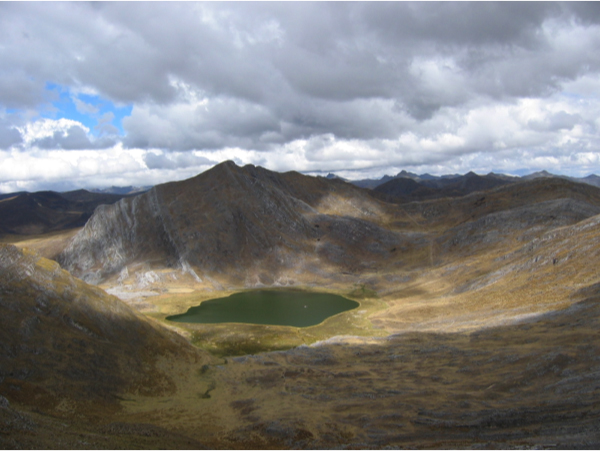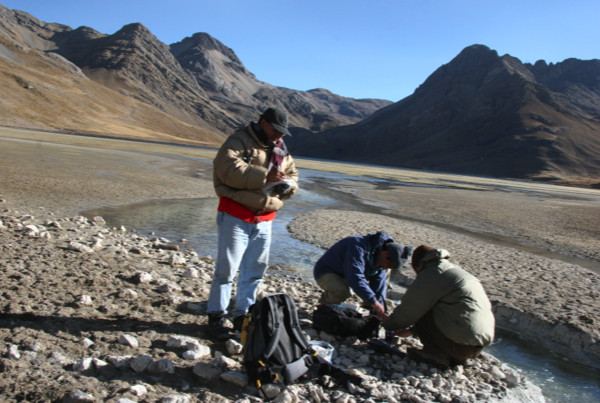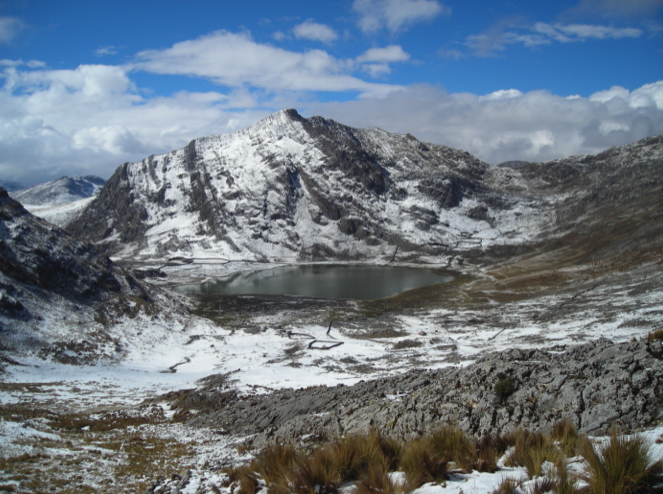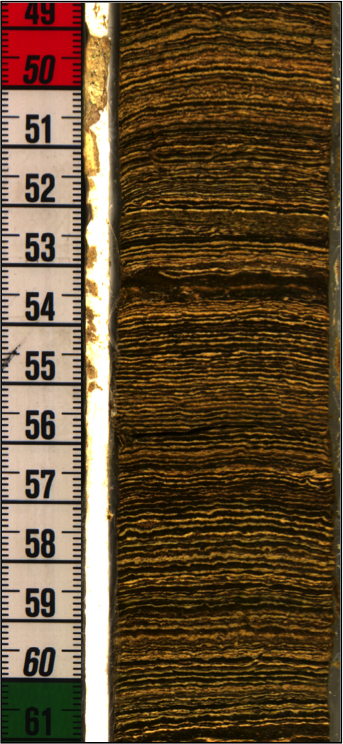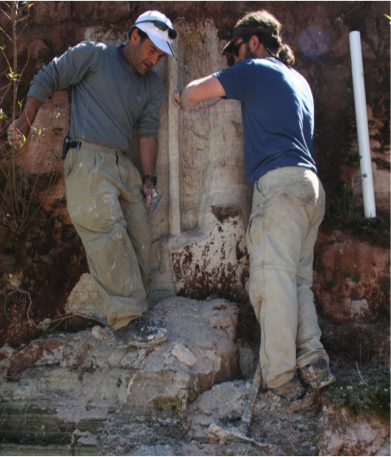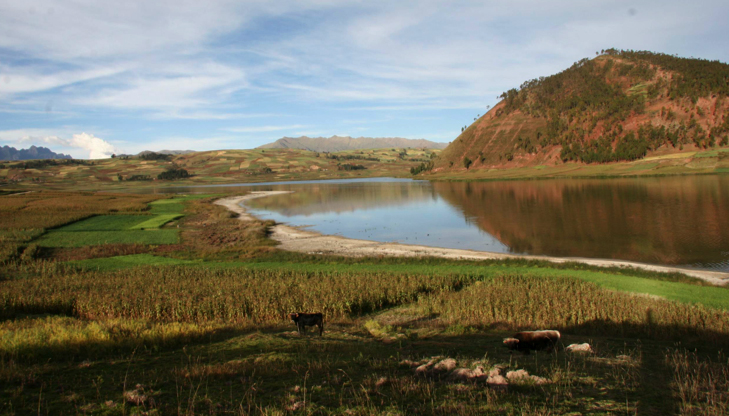 |
||||||||||||||
|
|
||||||||||||||
|
Peruvian Andes
|
|
Late Holocene Climate of the Central Andes Identified from Sedimentary, Stable Isotopic, Geochemical and Biological Proxies - Collaborators include Don Rodbell, Nathan Stansell, Broxton Bird, Byron Steinman, Alex Wolfe, Colin Cooke, Bryan Mark, Mathias Vuille, Alejandro Chu, Pedro Taypia, among others
This project focused on obtaining high-resolution paleoclimate records from a series of lakes in the central Andes spanning 11°S to 20°S. Our goal is to document climatic variability at the highest possible temporal-resolution from lakes in this region, which is reasonably in the range of 5 to 20 years based on previous work, sediment layer-thickness, and sedimentation rates (5 to 10 mm/decade). The resulting spatial-temporal dataset provides information regarding drought frequency, intensity, and spatial variability across a region with millions of people living at a subsistence level, limited water-resources, and rapidly retreating glaciers that currently supply an important source of water during the winter dry season. Publications resulting from this work include A 2,300-Year-Long Annually Resolved Record of the South American Summer Monsoon from the Peruvian Andes. Decadal and centennial mean state changes in South American summer monsoon (SASM) precipitation during the last 2,300 years are detailed using an annually resolved authigenic calcite record of precipitation d18O from a varved lake in the Central Peruvian Andes. This unique sediment record shows that d18 O peaked during the Medieval Climate Anomaly (MCA) from A.D. 900 to 1100, providing evidence that the SASM weakened considerably during this period. Minimum d18O values occurred during the Little Ice Age (LIA) between A.D. 1400 and 1820, reflecting a prolonged intensification of the SASM that was regionally synchronous. After the LIA, d18O increased rapidly, particularly during the current warm period (CWP; A.D. 1900 to present), indicating a return to reduced SASM precipitation that was more abrupt and sustained than the onset of the MCA. Diminished SASM precipitation during the MCA and CWP tracks reconstructed Northern Hemisphere and North Atlantic warming and a northward displacement of the Intertropical Convergence Zone (ITCZ) over the Atlantic, and likely the Pacific. Intensified SASM precipitation during the LIA follows reconstructed Northern Hemisphere and North Atlantic cooling, El Nino-like warming in the Pacific, and a southward displacement of the ITCZ over both oceans. These results suggest that SASM mean state changes are sensitive to ITCZ variability as mediated by Western Hemisphere tropical sea surface temperatures, particularly in the Atlantic. Continued Northern Hemisphere and North Atlantic warming may therefore help perpetuate the recent reductions in SASM precipitation that characterize the last 100 years, which would negatively impact Andean water resources.
Holocene Tropical South America Hydroclimate Revealed from a Decadally Resolved Lake Sediment d18O Record. Oxygen isotope ratios of authigenic calcite (d18Ocal) measured at annual to decadal resolution from Laguna Pumacocha document Andean precipitation variability during the last 11,200 years. Modern limnological data show that Pumacocha d18Ocal reflects the average annual isotopic composition of the lake's surface waters (d18Olw), and that d18Olw tracks the isotopic composition of precipitation (d18Oprecip), which is largely controlled by the intensity of the South American summer monsoon (SASM). Based on these relationships we use down-core d18Ocal measurements as a proxy for d18Oprecip that varies with the intensity of SASM precipitation. Pumacocha d18Ocal increased rapidly between 11,200 and 10,300 yr BP from -14.5‰ to -10.5‰, reaching a maximum of -10.3‰ by 9800 yr BP. After 9800 yr BP, d18Ocal underwent a long-term decrease that tracked increasing Southern Hemisphere summer insolation, suggesting that enhanced SASM precipitation was linked to precessional forcing. Higher-frequency trends did not follow insolation and therefore rep- resent other variability in the climate system. Millennial-scale trends from Pumacocha strongly resemble those from lower-resolution tropical Andean ice and lake core isotopic records, particularly the Huascaran ice core, and low elevation speleothems. These relationships suggest that tropical Andean isotopic records reflect variations in precipitation intensity related to precessional forcing rather than tropical temperatures. They also demonstrate a coherent pattern of SASM variability, although with differences between low elevation and Andean records during the late glacial to Holocene transition and the late Holocene. Centennial and decadal SASM precipitation variability is also apparent. Reduced SASM rainfall occurred from 10,000-9200, 7000-5000, 1500-900 yr BP, and during the last 100 years. Intensifications of the SASM occurred at 5000, 2200-1500, and 550-130 yr B.P. with the amplitude of variability increasing after 2200 yr BP. These periods may represent SASM responses to ocean-atmosphere variability related to orbital and radiative forcing (e.g., El Nino Southern Oscillation and the Intertropical Convergence Zone).
Proglacial Lake Sediment Records of Holocene Climate Change in the Western Cordillera of Peru. Sediment records from proglacial lakes between 9 and 10°S in the western Cordillera of the Peruvian Andes document the waxing and waning of alpine glaciers since the end of the late glacial stage. These records from the southern tropical Andes provide supporting evidence that the early Holocene (between 12 and 8 ka) was relatively warm and dry, and the middle Holocene (between 8 and 4 ka) was marked by a shift to cooler, and possibly wetter conditions in certain regions, leading to glacial advances. Although there were multiple periods of brief ice advances that interrupted the overall trend, glaciers in multiple valleys generally retreated from ~4.0 ka through the Medieval Climate Anomaly (1.0-0.7 ka). This late Holocene pattern of ice retreat occurred during a period when lake level studies, and both lacustrine and speleothem stable isotopic records indicate wetter conditions relative to the middle Holocene, suggesting that higher temperatures contributed to the pattern of ice retreat. Following this period of glacial retreat, multiple proxy records suggest that the start of the Little Ice Age (~0.6-0.1 ka) was a colder and wetter time throughout much of the tropical Andes. There appear to be two primary synoptic-scale climatic controls on temperature and precipitation linked to insolation dynamics that drive changes in ice cover in the southern tropical Andes during the Holocene: 1) the strength of the South America Summer Monsoon, which is linked to Northern Hemisphere temperatures and the mean position of the Inter- tropical Convergence Zone over the Atlantic, and 2) sea surface temperature distributions in the tropical Pacific Ocean and its influence on atmospheric temperature, precipitation and circulation patterns. |
|
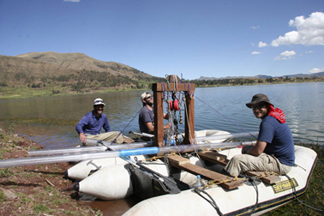
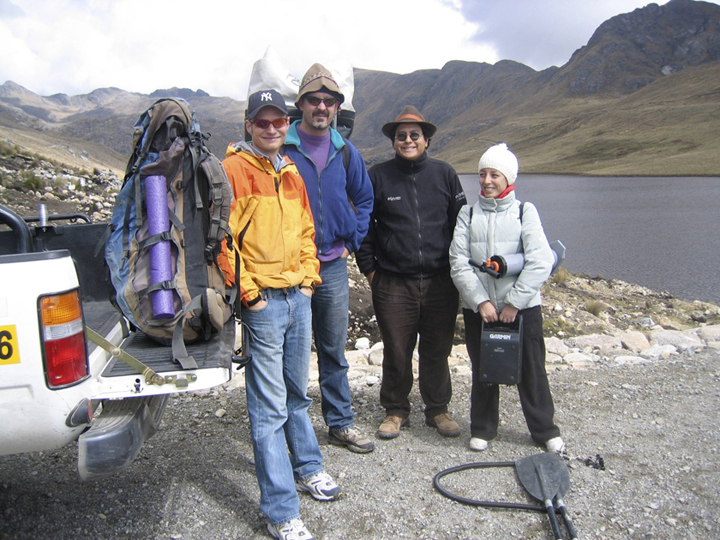 Above left Don Rodbell, Broxton Bird, and Nathan Stansell coring Laguna Puray just outside Cusco. Above right Colin Cooke, Alex Wolfe, Alejandro Chu, and Rosio near Cusco Peru.
Above left Don Rodbell, Broxton Bird, and Nathan Stansell coring Laguna Puray just outside Cusco. Above right Colin Cooke, Alex Wolfe, Alejandro Chu, and Rosio near Cusco Peru.